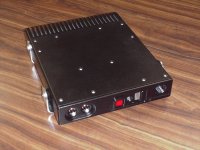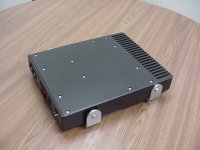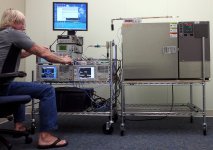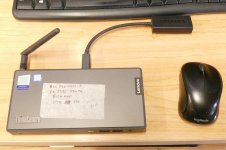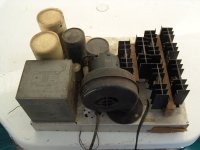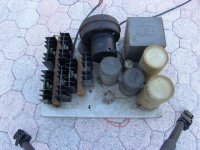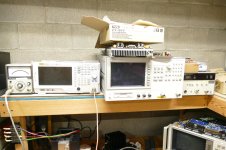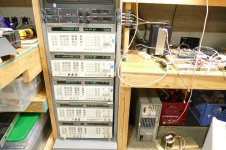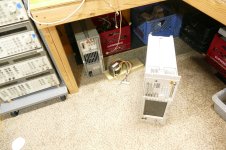I've migrated to Dell MFF machines with SSD. i7s 13th and 14th gen. I buy them on the Dell Outlet store. They are small, fit nicely on the desktop, are quiet and have plenty of USB-C, ethernet and DP interfaces.
For the HT I have a four year old Dell i7 with Win10 Pro. With an ASUS USB 7.1 audio decoder. It's video processing is good enough out of its HDMI interface so it feeds the LG OLED as a 1080p display running VLC The TV itself does its own upscaling to whatever native resolution it has (it's a 4K thing).
For trips I've moved to Chromebooks. They are cheap, they have multiple USB so I can use them as audio players with an USB-OTG to the DAC and power. I bought an Acer from Costco for under 200 bucks and put a 1TB memory card in it. Works great for email, audio, browsing. And I prefer the touchscreen interface over a standard tablet ( I do have three Android tablets of my own).
Our phones are Android with big memory cards. I don't what the future holds there. We prefer the memory cards, that's where the pictures get stored. If the phone dies, it's trivial to grab the pictures out of it. We don't do/pay for external cloud storage as we have 120TB NAS storage at home with a reasonable back up regime using a fire/water proof safe. Right now those using my phone with 1TB storage and a small USB DAC is nice for trips -like airplanes- and for Android Auto in the car.
Naturally we have Raspberries.
Work is different. They gave me an i9 and I make the builds in there. For a full build it takes about 20 minutes -files/compiler/tools are local to the drive. Ideally, if I were an employee, I'd ask for a Xeon in the lab so I could move the builds there and make the build in less than 10 minutes. But, as a contractor I get paid by the hour, so be it.
OH, I got an Ubuntu Apache server that is a 23 year old Pentium machine with a GigE board. Still working fine. Knock onwood silicon. I updated the OS about 10 years ago.
For the HT I have a four year old Dell i7 with Win10 Pro. With an ASUS USB 7.1 audio decoder. It's video processing is good enough out of its HDMI interface so it feeds the LG OLED as a 1080p display running VLC The TV itself does its own upscaling to whatever native resolution it has (it's a 4K thing).
For trips I've moved to Chromebooks. They are cheap, they have multiple USB so I can use them as audio players with an USB-OTG to the DAC and power. I bought an Acer from Costco for under 200 bucks and put a 1TB memory card in it. Works great for email, audio, browsing. And I prefer the touchscreen interface over a standard tablet ( I do have three Android tablets of my own).
Our phones are Android with big memory cards. I don't what the future holds there. We prefer the memory cards, that's where the pictures get stored. If the phone dies, it's trivial to grab the pictures out of it. We don't do/pay for external cloud storage as we have 120TB NAS storage at home with a reasonable back up regime using a fire/water proof safe. Right now those using my phone with 1TB storage and a small USB DAC is nice for trips -like airplanes- and for Android Auto in the car.
Naturally we have Raspberries.
Work is different. They gave me an i9 and I make the builds in there. For a full build it takes about 20 minutes -files/compiler/tools are local to the drive. Ideally, if I were an employee, I'd ask for a Xeon in the lab so I could move the builds there and make the build in less than 10 minutes. But, as a contractor I get paid by the hour, so be it.
OH, I got an Ubuntu Apache server that is a 23 year old Pentium machine with a GigE board. Still working fine. Knock on
Hi George,
Walking out was wise. They would have abused you forever more if you hadn't.
Those were replaced under warranty, but data loss cost more. I bought the newer Conner drives to replace them (along with 286's). While fighting with Seagate, I bought a Tallgrass external HD and tape drive unit. Saved my bacon a few times.
I also bought the MC68HC705 dev kit way back. It was a good kit.
Yes, they were like a sewing machine. I had to buy new as they were demanded for "talking" to studio multi-track tape machines via RS-232. $5K each at the time, 8088 (Compaq was an 8086). Of course, never used them, they were a condition of a contract. My kids ended up using them as youngsters, and they graduated to newer machines as I upgraded at my business. They were computer-savvy at a very young age.
Today my newest machine is an i7 Lenovo, the others are i5 Lenovo machines. Laptops are newer. I haven't a clue what processors are now. I simply want them to work. I did just receive a 2TB SSD for a small Thinkcentre. I'll load Mint on it for a spin, I think it is an i5 as well.
Walking out was wise. They would have abused you forever more if you hadn't.
Those were replaced under warranty, but data loss cost more. I bought the newer Conner drives to replace them (along with 286's). While fighting with Seagate, I bought a Tallgrass external HD and tape drive unit. Saved my bacon a few times.
I also bought the MC68HC705 dev kit way back. It was a good kit.
Yes, they were like a sewing machine. I had to buy new as they were demanded for "talking" to studio multi-track tape machines via RS-232. $5K each at the time, 8088 (Compaq was an 8086). Of course, never used them, they were a condition of a contract. My kids ended up using them as youngsters, and they graduated to newer machines as I upgraded at my business. They were computer-savvy at a very young age.
Today my newest machine is an i7 Lenovo, the others are i5 Lenovo machines. Laptops are newer. I haven't a clue what processors are now. I simply want them to work. I did just receive a 2TB SSD for a small Thinkcentre. I'll load Mint on it for a spin, I think it is an i5 as well.
Motorola had lots of the old beige MacIntosh computers before Windows became a useful tool. I refused to use a Mac, but had to "keep up with the Mac boys" in the graphic slides department. GEM was about as useful as an old Mac for a while. There were two different camps at Mot, the Mac guys who had to run floppies around and the IBM guys who had a Token Ring network which was slow, but faster than running down the hall, up the stairs, then back down the hall. We are talking the stone age here, and slides were made on copy machines for use on projectors in meetings. It's sad but true, he who has the best slides wins.I remember booting GEM a couple of times and wondering how that was useful.
In the later days of zooming automated PowerPoint presentations the same applied. A reorganization in Chicago left our research group reporting to a totally different group who did not know any of us. They told everyone from the high level managers to the guy who ordered parts and soldered boards for us to prepare a presentation for them to judge each of us by. They would be in Florida in one week! massive panic ensued. All useful work ceased. People were frantically making slides, but I made none. We were given 15 minutes each to justify our jobs. Even my boss called me aside and said that this was serious, I should get busy. I said that I had a plan and something nobody else had. I would make a BIG BANG with my very short presentation and use ZERO slides.
The big meeting came in a big conference room with a big wooden table in the middle. All slides were delivered by USB thumb drive. Presenters were asked to explain things to those judging us without a clue as to what we did or why it was necessary. Most of the high level engineers did not build or make any hardware. They were simulator jockeys with Agilent's ADS / MDS as their only tool. These guys were specialized down to one or two specific stages in a two-way radio design. We had frequency synthesis guys, RF front end guys, RF power amp guys, and the like.
I got the call somewhere in the middle of the second day, with some info from those grilled in day one. I picked up my 12 pound secret weapon, removed the mounting brackets to avoid damage., and carried it into the room dressed in my usual jeans, T-shirt and Flip Flops. The Chicago boys were chatting among themselves when I dropped that brick down in the middle of the table. I instantly had everybody's attention. I explained that lots of people here make far better slides than I do, however Motorola does not sell pretty slides. Motorola sells police radio equipment, and they want to sell high speed data radios. That black box is the only high speed data radio in existence for the newly allocated 700 MHz public safety frequency band. I designed the transmitter, laid out the entire PC board inside, drew up the plans for the housing and got it made in the machine shop, got the PC boards made in the PC board shop, got them populated in the build lab, put the radio together, and tested it. I don't make slides, I make radios. Any questions. After all the panic nobody was terminated. Several people were offered buyouts and a few took them. After 41 years at Mot, I took a buyout in 2014.
I included a picture of me testing a better data radio in 2010 that ran LTE.
Attachments
I have one of those. It is an i5 and did successfully upgrade to W11. Mine also came with a 1 TB SSD and an empty slot where a 2 TB currently resides. I used it quite a bit when I got it, but I currently have an industrial 4 X 4 inch PC in its place. Newegg closed them out at $150 each about a year ago and it runs a Ryzen 7.I did just receive a 2TB SSD for a small Thinkcentre. I'll load Mint on it for a spin, I think it is an i5 as well.
Attachments
... I explained that lots of people here make far better slides than I do, however Motorola does not sell pretty slides. Motorola sells police radio equipment, and they want to sell high speed data radios. That black box is the only high speed data radio in existence for the newly allocated 700 MHz public safety frequency band. I designed the transmitter, laid out the entire PC board inside, drew up the plans for the housing and got it made in the machine shop, got the PC boards made in the PC board shop, got them populated in the build lab, put the radio together, and tested it. I don't make slides, I make radios. Any questions. After all the panic nobody was terminated. Several people were offered buyouts and a few took them. After 41 years at Mot, I took a buyout in 2014.
I included a picture of me testing a better data radio in 2010 that ran LTE.
Is that the HP power meter on top of the stack? ...;-) HPIB baby, HPIB.... Paid my mortgage for years with that.
++++
Truly the proper attitude, but you still had to deal with the buffoons, huh?
I really knew my days at Boeing were gonna be cut short, by me, when I was in the design peer review and I pointed out that the hardware they'd chosen would take five minutes to reboot. And while that happened, the rear cockpit displays would be blank... furthermore I pointed out that the defensive/offensive officers would not be able to see the datalink, the situational awareness displays nor any incoming threats.
The hardware and systems guy told me that all they had to do was wait for five minutes and the datalink would start populating... it would not be a big deal.
So, I got on ON THE TABLE, swang my arms backwards as a B1B going supersonic for a bomb run... said "BOOM.... EMP! "... jumped off the table... said "I'm the pilot, ****! where are we? We're outta here!" Made a 180 turn, squatted low and "flew" out the door with a couple of neat evasive turns.
The room behind me, all 20+ people, was silent.
I came back.... the Big Shot Program Manager and my buddy in the systems group were laughing and applauding. "Good Job.... He's right! No pilot is gonna stick around for five minutes, not even one!" The program manager was an ex USAF bomber pilot. He understood the seriousness of the problem immediately when I described it.
I knew then that if The Software Guy understood the product and its use cases better than the Systems and Hardware guys.... if ONE GUY, in a team of 150, understood the problem, after all the money that went into it.... it was just an impossible task.
So we fixed that... then I went to another program... we had a spurious timeout on a GPS in the two test planes. I looked at the data, the timing, the software, had flown in the plane, had seen the test wiring, I figured a loose test connector. They didn't believe me, but the Director told me to go give it a try. I took two ex USAF O5s who knew their stuff, we looked in detail at the timing (someone had to do the slides.. not me ).... I wrote some special builds and got them approved by the AF, went a couple of flights and proved it: On take off, the connectors were been shaken causing an intermittent loss of continuity so the SW (mine) would debounce it and time out. AF did a continuity check and sure enough I was correct.
About that point I figured than in commercial company I would have been promoted to Senior Principal Fellow, but in a MIC program, all they wanted was paper pushers for those positions.
Oh here comes the best for last. This one is beauty...
We were upgrading the hardware and software because we were pushing past the 50% CPU usage. It was a $200M, 3 year project.
I was in charge of the backplane and doing some VME IO work and started to look at the background tasks... lo and behold I saw a glaring error.... Basic error. So I fixed it. Spent a whole week in the lab getting data so I could present it to the management. Turns out I had saved 6.5% and 7.5% of CPU usage on our boards. It was, incredible, simple as adding two lines and deleting 250.... absolutely no loss of functionality, it was simple, they had made a boneheaded design decision. It has been working like for years, on 180 aircraft in the fleet.
I went to the Director first and told me my findings. He closed the door and said to me "You are right, great job, but if we announce this we won't need to rebase the computer and we won't need the $200M contract..."
I had saved the taxpayers $200M plus God Knows how much more in the Pentagon.
So, I quit the MIC.
BTW- SHOES - no high heels- are always REQUIRED in our labs. Some labs even required steel toed shoes. I have them.
... when I left college, Physics, I went to make baby killing bombs.
... when Nelson left college, Physics, he went to make amplifiers
I'm so jealous of Nelson Pass.
Last edited:
^ Nelson, that's very kind of you.. I'm good at making bombs, but when I make amps, I tend to SMOKE them.
Oh well, the Zenductor and Zon Of Zenductor are working fine. It's a robust design. Even when I put one of the output transistors backwards it did not blow up and destroy anything. It works fine now. ;-)
It is fun making amps. Indeed.
Oh well, the Zenductor and Zon Of Zenductor are working fine. It's a robust design. Even when I put one of the output transistors backwards it did not blow up and destroy anything. It works fine now. ;-)
It is fun making amps. Indeed.
Hi George,
Mine has one slot.
I ran sneakernet, then 10BaseT, then Ethernet. The first networking guys I hired couldn't get NT4 running on a network, so I pulled it out, ran around with floppies. I saw a copy of OS/2 server 3. something in a flea market and bought it and it ran no problem. Then OS/2 ver4 server and finally 5 advanced. From there I went into telecom and certified on VoIP on the first course Avaya offered up here. I didn't have any formal networking instruction, I just made it work. I rebuild voice mail servers and recovered data. I hate computers by the way! I'm an analogue audio guy that loved test equipment (certified calibration/repair tech) also.
You were very effective in the boardroom. Bravo! A manager with an ego still could have killed you. You're so right. Not many actually understand the "mission" and can make it happen. "We'll fix it in the field" is one of the most stupid things I have ever heard.
Hey Tony,
You still make bombs in that case! lol! Nelson, he gets to play and experiment. That's the life to live.
Mine has one slot.
I ran sneakernet, then 10BaseT, then Ethernet. The first networking guys I hired couldn't get NT4 running on a network, so I pulled it out, ran around with floppies. I saw a copy of OS/2 server 3. something in a flea market and bought it and it ran no problem. Then OS/2 ver4 server and finally 5 advanced. From there I went into telecom and certified on VoIP on the first course Avaya offered up here. I didn't have any formal networking instruction, I just made it work. I rebuild voice mail servers and recovered data. I hate computers by the way! I'm an analogue audio guy that loved test equipment (certified calibration/repair tech) also.
You were very effective in the boardroom. Bravo! A manager with an ego still could have killed you. You're so right. Not many actually understand the "mission" and can make it happen. "We'll fix it in the field" is one of the most stupid things I have ever heard.
Hey Tony,
You still make bombs in that case! lol! Nelson, he gets to play and experiment. That's the life to live.
Networking.... in the early 90s I was doing internetworking and we had that quake in Northridge.
I brough a router (our product), a switch (!), a hub and a couple of laptops from the office ( DOS 3.2WG ) and I set them up at home. My own machines were 486DX, one with W95 and another with NT4.
I had a dial up connection to the local office and set up a VPN. Using CLI to the Unix machines.
The W95 became my actual router, the gateway, so I had two ethernet cards in it. LAN on one side, WAN to an ethernet to dial up modem, a separate part form work. Soon enough, by 95, I got ISDN so I started using a Motorola BitSufr Pro.
Did you know that in NT, the ethernet cards were numbered in the OS when you went to configure them.. but in W95 they were not, so you really didn't know which was which, so the idea was that your installed and configured the first card, ONLY THEN, did you install and configured the second card. I forget the software I was using then, but it did NAT.
Now, one little detail about getting networking running in a home LAN in the 90s. It helped tremendously if the liquor cabinet was nearby, because it really drove you to drink. In the mid 90s I started working at a World Famous Lab north of here. The guy I worked with was also setting up his home LAN. One day he asked me if I had a liquor cabinet. It was funny, we both spent hours in the early hours of the night setting up our home LANs... and we'd end up drinking scotch to relax....
Cable routing showed up in 97. I was one of the very firsts in the area... got free service for three years as I configured a DMZ for them to check the status.
801.11b in '00. First residential installation in the area. It was me and the University down the street, and two miles beyond my job. CSCO. The fools at the university were not putting passwords, so I could log in with impunity if I wanted. I had passwords... I had noticed the IT jerks would drive around the area sniffing for networks... You see, I was sniffing them too. ;-)
Users. They think they're so smart.
I'm no longer making bombs... right now I'm just trying to get AFDX to work. Typical Euros to complicate things.
I brough a router (our product), a switch (!), a hub and a couple of laptops from the office ( DOS 3.2WG ) and I set them up at home. My own machines were 486DX, one with W95 and another with NT4.
I had a dial up connection to the local office and set up a VPN. Using CLI to the Unix machines.
The W95 became my actual router, the gateway, so I had two ethernet cards in it. LAN on one side, WAN to an ethernet to dial up modem, a separate part form work. Soon enough, by 95, I got ISDN so I started using a Motorola BitSufr Pro.
Did you know that in NT, the ethernet cards were numbered in the OS when you went to configure them.. but in W95 they were not, so you really didn't know which was which, so the idea was that your installed and configured the first card, ONLY THEN, did you install and configured the second card. I forget the software I was using then, but it did NAT.
Now, one little detail about getting networking running in a home LAN in the 90s. It helped tremendously if the liquor cabinet was nearby, because it really drove you to drink. In the mid 90s I started working at a World Famous Lab north of here. The guy I worked with was also setting up his home LAN. One day he asked me if I had a liquor cabinet. It was funny, we both spent hours in the early hours of the night setting up our home LANs... and we'd end up drinking scotch to relax....
Cable routing showed up in 97. I was one of the very firsts in the area... got free service for three years as I configured a DMZ for them to check the status.
801.11b in '00. First residential installation in the area. It was me and the University down the street, and two miles beyond my job. CSCO. The fools at the university were not putting passwords, so I could log in with impunity if I wanted. I had passwords... I had noticed the IT jerks would drive around the area sniffing for networks... You see, I was sniffing them too. ;-)
Users. They think they're so smart.
I'm no longer making bombs... right now I'm just trying to get AFDX to work. Typical Euros to complicate things.
Last edited:
Somewhere in the early 70's they announced the steel toed shoes in the factory area mandate. That lasted for maybe two weeks since Motorola could be required to pay for them according to Florida law. Before I could even hide my flip flops that plan was changed to "closed toed shoes in the factory," flip flops were forbidden. I kept an old worn out pair of loafers under my desk in the cal lab for the few night shift bosses that actually enforced that rule. I made sure that I took my time going back to the lab to change shoes when refused access so there wasn't much enforcement.BTW- SHOES - no high heels- are always REQUIRED in our labs. Some labs even required steel toed shoes. I have them.
When I went to college twice BSCE and MSEE, I went to make amplifiers, lots of them blew up, some spectacularly so I also made bombs.... when I left college, Physics, I went to make baby killing bombs.
... when Nelson left college, Physics, he went to make amplifiers
Ever blow a TO-3 transistor so bad that molten metal flew through the lid? I did it, twice. I used rectified wall outlet for power back in my high school years. Never did that again. I rebuilt the same booster amp with a 75 volt 4 amp transformer and it lived. It made somewhere between 250 and 350 watts into 4 ohms. Not bad for a 16 year old kid in 1969. I found it again in 2007, plugged it in and it tried to blow up again. I set it outside on the driveway plugged it into an extension cord got 50 feet away and plugged the cord into the wall outlet. Smoke and stink shot from the underside then the extension cord got really hot. I yanked it. One of the ancient electrolytics had shorted. I kept the heat sinks, tossed the rest.
The ZAPPA label has nothing to do with frank. It was the nickname I got from the high school electronics teacher. Yes, things blew up and tubes malted in high school too. We had a 3 year vocational electronics program that taught the basics then focused on TV repair. Our textbooks were printed in the 1950's by Philco, so there was no solid state stuff. Most of the lab material that we used to experiment with came from a refurb of the electronics shop in the nearby Homestead Air Force Base. I had an unlimited supply of NOS RCA metal 6L6 tubes. The teacher bet me that I couldn't make the outer metal envelope glow red. It took several tries and stunk up the entire vocational wing of the school, but stink was always blamed on the auto shop class. The glass seal inside the tube would melt before the outer shell glowed, but the phenolic base had already started burning.
Attachments
lol!
Hi Tony,
Yeah, but they couldn't get NT4 working with one card on a simple network. I don't know what they did wrong. I shut the Windows box down, then later loaded up the OS/2 server, different machine. After that I sparked up the NT4 box and set it up, no problem.
Absolutely! Nothing is more frustrating than computer software or networking when that is not your job or interest. I flipping hate all the waiting.
H George,
Steel toed shoes are mandated in all factory floors and most warehouses here. Mine are sitting in the frozen garage. We had to buy our own.
Yup! Melted (actually cut) TO-3 cases, and also the bottom metal cover on a Carver PM 1.5 that some idiot plugged into 550VAC. Absolutely everything had failed, and what wasn't obviously dead was surrounded by char. Spectacular! Never did see 6L6 (metal) cases burned, but the two plates on a 5U4 both melted with missing sections - yeah! Usually burned transformers, you can smell them a long way off!
I guess the two of you are our official bomb makers.
Hi Tony,
Yeah, but they couldn't get NT4 working with one card on a simple network. I don't know what they did wrong. I shut the Windows box down, then later loaded up the OS/2 server, different machine. After that I sparked up the NT4 box and set it up, no problem.
Absolutely! Nothing is more frustrating than computer software or networking when that is not your job or interest. I flipping hate all the waiting.
H George,
Steel toed shoes are mandated in all factory floors and most warehouses here. Mine are sitting in the frozen garage. We had to buy our own.
Yup! Melted (actually cut) TO-3 cases, and also the bottom metal cover on a Carver PM 1.5 that some idiot plugged into 550VAC. Absolutely everything had failed, and what wasn't obviously dead was surrounded by char. Spectacular! Never did see 6L6 (metal) cases burned, but the two plates on a 5U4 both melted with missing sections - yeah! Usually burned transformers, you can smell them a long way off!
I guess the two of you are our official bomb makers.
Hey, I had this 252SIT......
"daddy, what's that smell?"
I attract bombs.
Funny..... tubes.... I worked on a number of metrology labs for years, writing software for their test sets. It was fun. They usually had a big warehouse in the back and we'd have free reign. In several companies, it was a "get your free tube" paradise. That's when I bought my first ARC D70-II and a CJ PV9. I was set for tubes for years, including the tube matching machines. That streak ran until well into '90 when they all got rid of tubes... I don't think I bought a tube until the mid 00s.
I think we're old.... except I think I'm the youngster here. 👶👶
EDIT... just so we're clear.... I bought that amp and preamp USED, of course.
"daddy, what's that smell?"
I attract bombs.
Funny..... tubes.... I worked on a number of metrology labs for years, writing software for their test sets. It was fun. They usually had a big warehouse in the back and we'd have free reign. In several companies, it was a "get your free tube" paradise. That's when I bought my first ARC D70-II and a CJ PV9. I was set for tubes for years, including the tube matching machines. That streak ran until well into '90 when they all got rid of tubes... I don't think I bought a tube until the mid 00s.
I think we're old.... except I think I'm the youngster here. 👶👶
EDIT... just so we're clear.... I bought that amp and preamp USED, of course.
Last edited:
Just about every piece of test equipment in the whole Motorola plant was HP. I had two racks full of HPIB connected HP gear in my corner of the lab, and I commandeered an empty office for the noisy temperature chamber testing work.Is that the HP power meter on top of the stack? ...;-) HPIB baby, HPIB.... Paid my mortgage for years with that.
So after dealing with all of that fun HP stuff at work for 40+ years, what do I have at home?
Note the TWO HP RF power meters. Oldies but goodies. All of the RF signal generators were purchased in non working condition. I bought six and a half of them and got five working units. There might be a ham radio design in the works, but I haven't got very far. No tubes though. All my ham radio experiments in the past were solid state.
Attachments
Hey, I still have my late 70s Radio Shack meter... with the big needle. Works great - OK, I do have three of them modern fancy things with those number display. Digital, I think they call them?
I may smoke the UUT, but never the measuring equipment.
I may smoke the UUT, but never the measuring equipment.
My networking career began with…
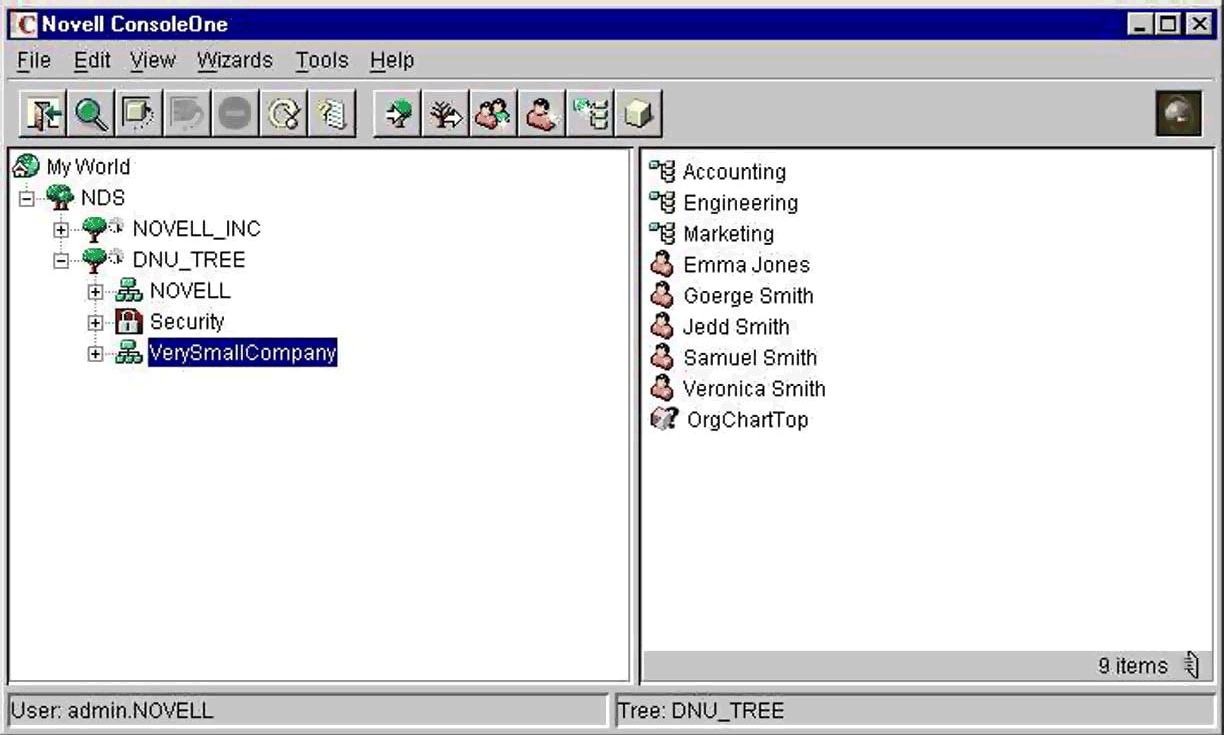
Then I was told that Windows NT was the next big thing. I wondered why. Then I got MCSE + Internet certified, and really wondered why. I was hired to start teaching MCSE Cert courses. I asked the business owner why NT was taking over. His answer, “jobs”. I didn’t really get it at the time, but that MCSE certainly did land me a good job, and then another. Once my career really got rolling, Windows was taking a distant back seat to Linux and the BSDs. This was a massive relief to me, as I went on to learn all of that, plus Cisco, Juniper, etc. etc. and Windows drifted onto the horizon.
So I can’t say I regret that MCSE, but I am damned glad it didn’t define my whole career.

Then I was told that Windows NT was the next big thing. I wondered why. Then I got MCSE + Internet certified, and really wondered why. I was hired to start teaching MCSE Cert courses. I asked the business owner why NT was taking over. His answer, “jobs”. I didn’t really get it at the time, but that MCSE certainly did land me a good job, and then another. Once my career really got rolling, Windows was taking a distant back seat to Linux and the BSDs. This was a massive relief to me, as I went on to learn all of that, plus Cisco, Juniper, etc. etc. and Windows drifted onto the horizon.
So I can’t say I regret that MCSE, but I am damned glad it didn’t define my whole career.
Generally don't smoke anything. Occasionally, but never test gear. That's too expensive.
I had a B&K 2830 I used in my shop. It's common was tied to earth ground, so I told the guys not to use it and why. One bright bulb connected it to a hot chassis. Replaced a few inches of copper foil and it was good to go again. The same genius shorted the protection diodes of my HP 4261A LCR meter. Fixed that. One gret meter was the FLuke 8200A DVMs (with options) I have. The display boards fail. There was almost a 7 segment nixie board designed for it, but I ran out of time
I had a B&K 2830 I used in my shop. It's common was tied to earth ground, so I told the guys not to use it and why. One bright bulb connected it to a hot chassis. Replaced a few inches of copper foil and it was good to go again. The same genius shorted the protection diodes of my HP 4261A LCR meter. Fixed that. One gret meter was the FLuke 8200A DVMs (with options) I have. The display boards fail. There was almost a 7 segment nixie board designed for it, but I ran out of time
Banyan, Novell.... we had them all in our routers. This is around '92. Before HTML. A coworker and I developed out own mark up language, but it was private for our company's products. We were tired of using SNMP. (*)
Decnet, Appletalk, X11, IPX, XNS... even IP... We were required to support every single crazy protocol that existed so our sales guys could make more sales.
Even if that meant that the cost of R&D went through the roof. 😛
We used to joke that if we disabled Appletalk then we would get a reprieve from the three times a meeting when the managers assigned bug fixes.... them managers had early models of the Apple laptops and they used Appletalk... they'd sit in a conference room, connect their laptops to the network and then go down the infinite list that our FAEs generated for R&D to look at.
A few years later I got my CCNA. I guess our manager thought IOS developers should have the CCNA. Even though we knew more about the subject that the instructors. Our test guys were all CCNE. Useful for them, not useful for us. We were subject matter experts. It has to be that way when you are in R&D.
So four of us went to this lab/classroom. They had some medium level CSCO routers and we all got broken up into groups and assigned an account/router.
During the exercises, heck during the lectures, while the hapless users around us were listening to the lecture we broke into all the routers and messed with their heads.
It's OK, at the end I think they learned a lot more by our explanations of how our routers worked and how they could use the CLI to do a lot more than the lectures were covering.
Once they figured out who our employer was... that is.
You know what is really funny.... as the internetworking technologies and digital electronics moved at an ever faster pace... Even consumer video... I kept the same audio system from '89 through '99.... tubes for many years.... the same belt in the Linn for so many years!
(*) I've lost track now, but until Y2K, Cisco's SNMP implementation was a translation to a CLI command! Everything in IOS was handled by the CLI.
Decnet, Appletalk, X11, IPX, XNS... even IP... We were required to support every single crazy protocol that existed so our sales guys could make more sales.
Even if that meant that the cost of R&D went through the roof. 😛
We used to joke that if we disabled Appletalk then we would get a reprieve from the three times a meeting when the managers assigned bug fixes.... them managers had early models of the Apple laptops and they used Appletalk... they'd sit in a conference room, connect their laptops to the network and then go down the infinite list that our FAEs generated for R&D to look at.
A few years later I got my CCNA. I guess our manager thought IOS developers should have the CCNA. Even though we knew more about the subject that the instructors. Our test guys were all CCNE. Useful for them, not useful for us. We were subject matter experts. It has to be that way when you are in R&D.
So four of us went to this lab/classroom. They had some medium level CSCO routers and we all got broken up into groups and assigned an account/router.
During the exercises, heck during the lectures, while the hapless users around us were listening to the lecture we broke into all the routers and messed with their heads.
It's OK, at the end I think they learned a lot more by our explanations of how our routers worked and how they could use the CLI to do a lot more than the lectures were covering.
Once they figured out who our employer was... that is.
You know what is really funny.... as the internetworking technologies and digital electronics moved at an ever faster pace... Even consumer video... I kept the same audio system from '89 through '99.... tubes for many years.... the same belt in the Linn for so many years!
(*) I've lost track now, but until Y2K, Cisco's SNMP implementation was a translation to a CLI command! Everything in IOS was handled by the CLI.
Last edited:
- Home
- Member Areas
- The Lounge
- I'm pulling up stakes in the Windows camp, dual-boot Linux as step #1
